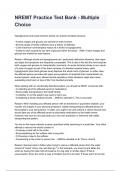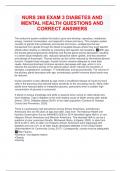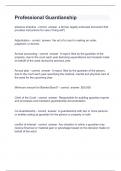NREMT Practice Test Bank - Multiple
Choice
Hypoglycemia and acute ischemic stroke can present similarly because:
• A:each oxygen and glucose are wished for brain function.
• B:most people of stroke sufferers have a history of diabetes.
• C:the maximum commonplace reason of a stroke is hypoglycemia.
• D:they're each caused by low tiers of glucose within the blood. - ANS• A:each oxygen and
glucose are wished for brain feature.
Reason: Although stroke and hypoglycemia are particularly distinctive situations, their signs
and signs and symptoms are frequently comparable. This is due to the fact the mind requires
both oxygen and glucose to characteristic commonly. An acute ischemic stroke is as a result
of a loss of oxygen to part of the brain because of a blocked cerebral artery, while
hypoglycemia (low blood glucose level) deprives the whole mind of glucose. In either case,
the affected person provides with signs and symptoms of impaired brain characteristic (ie,
slurred speech, weak spot, altered mental reputation). Both situations might also cause
everlasting mind harm or loss of life if not handled promptly.
When dealing with an emotionally disturbed patient, you should be MOST concerned with:
• A:collecting all of the affected person's medications.
• B:accurately transporting to the health facility.
• C:whether or not the patient may want to harm you.
• D:obtaining a whole medical records. - ANSYou selected C; This is accurate!
Reason: When handling any affected person with an emotional or psychiatric disaster, your
number one subject is your personal protection. Safely transporting the affected person to
the hospital is your last purpose. If viable, you ought to try and achieve a clinical records and
should take any of the affected person's prescribed medications to the health center.
However, this have to not supercede your very own protection or intervene with safely
transporting the patient.
You are on the scene wherein a person panicked whilst swimming in a small lake. Your initial
attempt to rescue him should consist of:
• A:rowing a small raft to the victim.
• B:accomplishing for the sufferer with a long stick.
• C:throwing a rope to the sufferer.
• D:swimming to the victim to rescue him. - ANSYou decided on B; This is correct!
Reason: General rules to follow when trying to rescue a affected person from the water
consist of "reach, throw, row, and then go." In this example, you must try and attain the
victim by having him take hold of preserve of a big stick or similar object. If that is
unsuccessful, throw the victim a rope or flotation tool (if to be had). If those aren't to be had,
,row to the affected person in a small raft (if to be had). Going into the water to retrieve the
victim is a remaining lodge. The rescuer should be a robust swimmer due to the fact
sufferers who are in risk of drowning are in a country of blind panic and will make each try
and preserve themselves afloat, even if it manner forcing the rescuer underwater.
How ought to you classify a affected person's nature of contamination if she or he has a low
blood glucose stage, weird behavior, and shallow respiration?
• A:Behavioral emergency
• B:Altered mental repute
• C:Respiratory emergency
• D:Cardiac compromise - ANSThe accurate answer is B;
Reason: The nature of contamination (NOI) is the scientific equivalent to mechanism of
injury (MOI). Altered mental status ought to be the suspected NOI in any patient with any
fluctuation in stage of awareness, which can variety from bizarre behavior to complete
unresponsiveness. Causes of an altered mental status include hypo- or hyperglycemia, head
trauma, stroke, behavioral crises, drug overdose, and shock, among others.
A young girl is unresponsive after overdosing on an unknown type of drug. Her respirations
are gradual and shallow and her pulse is sluggish and vulnerable. Which of the subsequent
tablets is the LEAST likely reason of her situation?
• A:Seconal
• B:Heroin
• C:Cocaine
• D:Valium - ANSThe accurate solution is C;
Reason: Of the medicine indexed, cocaine would be the least possibly reason of the
patient's circumstance. Cocaine is a significant worried gadget (CNS) stimulant; you would
assume her to be hypertensive, tachycardic, tachypneic, and perhaps even violent. Heroin,
Valium, and Seconal are all CNS depressants and could explain her situation. Heroin is an
unlawful narcotic (opiate), Valium is a benzodiazepine sedative-hypnotic drug, and Seconal
is a barbiturate. Narcotics, benzodiazepines, and barbiturates are all CNS depressants.
When taken in extra, they motive a decreased stage of attention, breathing despair,
bradycardia, and hypotension.
Activated charcoal is contraindicated for a patient who's:
• A:aware and alert and has ingested a large amount of Motrin.
• B:emotionally dissatisfied and has ingested two bottles of aspirin.
• C:agitated and claims to have ingested a bottle of Tylenol.
• D:wide awake and alert and has swallowed a industrial drain cleaner. - ANSYou decided on
D; This is correct!
Reason:Activated charcoal adsorbs (sticks to) many ingested materials, preventing them
from being absorbed into the body by means of the stomach or intestines. In some
instances, you could give activated charcoal to patients who've ingested certain substances,
if accredited by way of medical control or local protocol. Activated charcoal is contraindicated
for patients who have ingested an acid or alkali (ie, drain purifier) or a petrol product (ie,
,gas), who've a reduced level of attention and can not defend their very own airway, or who're
not able to swallow.
The MOST obvious manner to lessen warmness loss from radiation and convection is to:
• A:flow far from a chilly item.
• B:growth metabolism with the aid of shivering.
• C:wear a thick wind-proof jacket.
• D:move to a warmer environment. - ANSyou selected D; This is correct!
Reason:In a chilly surroundings, the frame has approaches of staying warm: producing
warmth (thermogenesis) and reducing heat loss. Radiation is the transfer of heat through
radiant energy. The body can lose heat by way of radiation, inclusive of while someone
stands in a chilly room. Convection occurs when warmness is transferred to circulating air,
as when cool air movements across the frame's floor. A character status in windy bloodless
weather, carrying light-weight garb, is losing heat to the surroundings primarily via
convection. The fastest and most apparent way to lower warmth loss from radiation and
convection is to move out of the bloodless environment and seek shelter from wind.
Shivering will increase the body's metabolism and is a mechanism for generating warmth,
now not decreasing warmness loss. Layers of garb entice air and offer exquisite insulation;
consequently, layered garb decreases warmth loss better than a single, thick jacket.
Conduction is the direct switch of heat from a part of the frame to a chillier item by way of
direct touch, as whilst a warm hand touches bloodless metallic or ice. The most obvious way
to decrease warmness loss by means of conduction is to eliminate your hand from the
bloodless item.
A close to-drowning is MOST correctly defined as:
• A:complications within 24 hours following submersion in water.
• B:immediate dying due to extended submersion in water.
• C:survival for at the least 24 hours following submersion in water.
• D:loss of life extra than 24 hours following submersion in water. - ANSYou decided on C;
This is correct!
Reason:Collectively, drowning and close to-drowning are called submersion injuries.
Drowning is described as dying after submersion in a liquid medium, typically water. In a
drowning, dying is either immediately or occurs inside 24 hours following submersion.
Near-drowning is defined as survival, as a minimum briefly (24 hours), after submersion. It
have to be stated, however, that complications which includes pneumonia and pulmonary
edema can reason dying greater than 24 hours following submersion. For this purpose, all
sufferers with a submersion damage should be transported to the health facility, despite the
fact that they appear satisfactory on the scene.
A younger girl reviews considerable weight reduction over the last month, chronic fever, and
night sweats. When you examine her, you word the presence of darkish red lesions masking
her trunk and top extremities. You must suspect:
• A:quit-degree cancer.
• B:HIV/AIDS.
• C:tuberculosis.
• D:rheumatic fever. - ANSYou decided on B; This is correct!
, Reason:Weight loss, fever, and night sweats may want to imply tuberculosis or HIV/AIDS;
but, the dark crimson lesions at the skin, which might be referred to as Kaposi's sarcoma,
are malignant skin tumors and are a conventional finding in patients within the later ranges
of AIDS.
A forty eight-12 months-old male became acutely hypoxic, skilled a seizure, and is now
postictal. The MOST effective manner to save you every other seizure is to:
• A:dim the lighting fixtures in the returned of the ambulance.
• B:vicinity him in the healing role.
• C:administer high-glide supplemental oxygen.
• D:supply him oral glucose if he can swallow. - ANSYou decided on C; This is accurate!
Reason:You should administer excessive-waft oxygen to all patients who're actively seizing
and to sufferers who skilled a seizure and are postictal. This is especially proper if the
seizure become as a result of hypoxia. Increasing the oxygen content of the blood, which
minimizes hypoxia, may save you every other seizure. The recovery function is suitable for
unhurt patients with a reduced degree of cognizance and adequate respiratory; it'll help
preserve the airway and facilitate drainage of secretions from the mouth, but will now not
save you any other seizure. Oral glucose may additionally prevent another seizure if
hypoglycemia turned into the motive of the seizure. You have to dim the lights in the returned
of the ambulance to help save you any seizure, no longer simply the ones that are as a
result of hypoxia.
Which of the following conditions will be the LEAST possibly to be found in a affected person
who become submerged in water?
• A:Spinal damage
• B:Gastric distention
• C:Hyperglycemia
• D:Laryngospasm - ANSYou selected C; This is correct!
Reason: Many elements can make a contribution to or end result from a submersion harm
(eg, drowning, close to-drowning). It is not uncommon for a person to revel in a spinal
damage after diving head first into shallow water, mainly if he or she is under the have an
impact on of alcohol. When a swimmer panics, he or she initially swallows big quantities of
water, ensuing in gastric distention. Gastric distention can motive aspiration if the patient
regurgitates water for the duration of rescue respiration; defend the airway! During the panic
section, the sufferer expends a extremely good quantity of energy (and glucose) from flailing
round within the water, likely resulting in hypoglycemia. Inhaling even a small quantity of
clean or salt water can significantly aggravate the larynx, which sends the muscle mass of
the larynx and vocal cords into spasm (laryngospasm), ensuing in airway blockage and
hypoxia.
A forty two-12 months-vintage male offers with fever, a extreme headache, and a stiff neck.
He is conscious, but confused. His wife tells you that he does not have any scientific troubles
and does now not take any medicinal drugs. You need to be MOST suspicious for:
• A:acute stroke.
• B:influenza.






